In his ongoing series of chess paintings, British artist Tom Hackney translates the chess games of influential artist and self-avowed chess fanatic Marcel Duchamp into vivid geometric abstractions.
Tom Hackney
 Tom Hackney (b. 1977, UK) lives and works in London. Painting forms the basis of Hackney’s art practice as a mode, a vessel, and as a narrative. Often generated in response to specific historical material, Hackney’s work incorporates pre-existing forms and structures, which are recreated and replayed as a means of exploring more contemporary stakes. Tom Hackney completed his Master of Fine Arts degree at Goldsmiths College, London, in 2008. Recent exhibitions include Tom Hackney: Corresponding Squares: Painting the Chess Games of Marcel Duchamp, Francis M. Naumann Fine Art, New York, and World Chess Hall of Fame, Saint Louis (2016) Reduction, ZS Art, Vienna (2015) Compression, Ormston House, Limerick (2015) Tom Hackney: Minerals, Ambacher Contemporary, Munich (2015) Spring Exhibition 2015, Kunsthal Charlottenborg, Copenhagen (2015) The John Moores Painting Prize, Walker Art Gallery, Liverpool (2014); Tom Hackney: Tremors, Breese Little, London (2013); and Motion Capture: Drawing and the Moving Image, Regional Cultural Centre, Letterkenny and Lewis Glucksman Gallery, Cork (2013). His work is represented in public and private collections in Europe and the United States.
Tom Hackney (b. 1977, UK) lives and works in London. Painting forms the basis of Hackney’s art practice as a mode, a vessel, and as a narrative. Often generated in response to specific historical material, Hackney’s work incorporates pre-existing forms and structures, which are recreated and replayed as a means of exploring more contemporary stakes. Tom Hackney completed his Master of Fine Arts degree at Goldsmiths College, London, in 2008. Recent exhibitions include Tom Hackney: Corresponding Squares: Painting the Chess Games of Marcel Duchamp, Francis M. Naumann Fine Art, New York, and World Chess Hall of Fame, Saint Louis (2016) Reduction, ZS Art, Vienna (2015) Compression, Ormston House, Limerick (2015) Tom Hackney: Minerals, Ambacher Contemporary, Munich (2015) Spring Exhibition 2015, Kunsthal Charlottenborg, Copenhagen (2015) The John Moores Painting Prize, Walker Art Gallery, Liverpool (2014); Tom Hackney: Tremors, Breese Little, London (2013); and Motion Capture: Drawing and the Moving Image, Regional Cultural Centre, Letterkenny and Lewis Glucksman Gallery, Cork (2013). His work is represented in public and private collections in Europe and the United States.
From the Curators
With a mission to interpret the game of chess and its cultural and artistic significance, the World Chess Hall of Fame is honored to present Tom Hackney’s first solo exhibition in the United States. Tom Hackney: Corresponding Squares: Painting the Chess Games of Marcel Duchamp was organized in collaboration with Francis M. Naumann Fine Art, New York. Hackney is a young British painter who has created geometric abstractions based on the movements of pieces in chess games. In the case of the present exhibition, the games were played by the celebrated French artist and chess player, Marcel Duchamp (1887-1968). In a speech at the New York State Chess Association in 1952, Duchamp remarked that playing a game of chess was like making a drawing. “The chess pieces are the block alphabet which shapes thoughts; and these thoughts, although making a visual design on the chessboard, express their beauty abstractly, like a poem.” In Hackney’s pictures, the beauty of those games is captured and made visible in a single static image. It was Duchamp’s goal to elevate art from a purely visual experience to something more cerebral, an aspiration that Hackney unquestionably accomplishes in these paintings whose beauty is generated entirely by ideas that took place on the 64 squares of a chessboard.
Having called his exhibition Corresponding Squares, Hackney subtly alludes to the book about endgame strategy, Opposition and Sister Squares Are Reconciled (1932) that Duchamp wrote with the Russian-born chess master Vitaly Halberstadt (1903-1967). Hackney chose the word “corresponding” to suggest that he has entered into a conversation with Duchamp’s games, an exchange that continues as chess players contemplate and attempt to decipher the moves that generated the rectilinear and diagonal patterns he has so skillfully and gracefully recorded. The paintings are made in black and white (like opposing chess pieces) or in color, based on a color-coded chess set that Duchamp designed in 1920.
Tom Hackney opened with great success at the Naumann gallery on March 18, 2016. The Saint Louis exhibition contains an added section of Duchamp history, photographs, and objects, which highlight the connection and inspiration his enduring legacy had on Hackney and his work. Additional contributions to the exhibition are essays, catalogue, and programming from Dr. Bradley Bailey, Associate Professor of Art History at Saint Louis University and Duchamp scholar, and Chess Champion and author Jennifer Shahade. This project marks the second collaboration between the Saint Louis Chess Campus and Francis M. Naumann Fine Art. Marcel Duchamp: Chess Master (2009), curated by Bradley Bailey, traveled from the Saint Louis University Museum of Art to Francis M. Naumann Fine Art. Bailey and Naumann wrote the accompanying catalogue Marcel Duchamp: The Art of Chess with game analysis by Jennifer Shahade.
—Shannon Bailey, Chief Curator, World Chess Hall of Fame
—Francis M. Naumann, Owner and Director, Francis M. Naumann Fine Art, New York
Layered Meaning
Considered by many to be the most influential artist of the 20th century, Marcel Duchamp effectively transformed the way we think about what an artist is and what an artist does. He achieved some notoriety early in the century as an avant-garde painter, particularly with the splash he made with his infamous painting Nude Descending a Staircase, No. 2, a cubist-inspired effort to render the movement of a figure through space that became the succès de scandale of the legendary Armory Show in New York in 1913. But by far his most important and controversial contribution to the history of art was his abandonment of painting to explore the concept of the readymade, which is an object—typically mass-produced—that is taken from material culture and transformed into a work of art simply through its selection by an artist and the context of its display. It is virtually impossible to consider the advancement of such later twentieth-century art movements as Pop, Minimalism, and Conceptualism without the introduction of the readymade.
A substantial portion of what the readymade was all about was Duchamp’s attempt to establish that what an artist does can be as or even more important than what an artist makes, which is the more traditional, artisanal understanding of artistic production. Case in point, Duchamp all but ceased producing art in the early 1920s in order to dedicate himself full-time to becoming a chess master and winning the French Chess Championship. This was a conscious decision to reinvent himself, and this process of reinvention was, in itself, an artistic act for Duchamp. But Duchamp even saw the latent aesthetic properties of playing chess, as he suggested during a 1959 interview with Truman Capote, “Why isn’t my chess playing an art activity? A chess game is very plastic. You construct it. It’s mechanical sculpture and with chess one creates beautiful problems and that beauty is made with the head and hands.” He sank himself so deeply into the game that many were convinced he actually had ceased to be an artist. While his chess achievements were modest by grandmaster standards, they were remarkable for a largely self-taught player who did not enter into the competitive arena until his mid-thirties, achieving master status at the relatively advanced age of 38. His most important accomplishments include winning the Chess Championship of Haute-Normandie in 1924, draws against such greats as Savielly Tartakower, Vera Menchik, Eugène Znosko-Borovsky, and the illustrious American Grandmaster Frank Marshall, and a victory over the brilliant blindfold exhibitionist George Koltanowski. Duchamp also made significant contributions to the chess community through the written word, authoring a chess column in the Parisian daily newspaper Ce Soir, translating Znosko-Borovsky’s book on chess openings into French, and coauthoring a book on endgame tactics with Vitaly Halberstadt titled L’Opposition et les cases conjuguées sont réconciliées (Opposition and Sister Squares Are Reconciled).
Yet it was Duchamp’s renunciation of art for chess that most inspired the artist Tom Hackney to engage with the former artist’s unusual path to chess mastery. “The idea for the chess paintings came out of my time at Goldsmiths [University of London], partly as a reflection on the strategic language applied in art discourse. I was also interested in Marcel Duchamp’s abandonment of art for chess—a ‘move’ in itself and something viewed as a direct challenge to the whole enterprise of painting. These elements combined, paradoxically, opened up a space for painting. Both activities (chess and painting) share an oscillation between the arenas of the eye and of the mind.” Hackney’s assessment echoes similar ideas from one of Duchamp’s reflections on the relationship between art and chess, “Chess has the visual possibilities of art. It is a mechanistic sculpture that presents exciting plastic values. If you know the game you can feel that the bishop is like a lever. It incites a whole new pattern when moved. There is a mental end implied when you look at the formation of the pieces on the board. The transformation of the visual aspect to the grey matter is what always happens in chess and what should happen in art.”
Patterns of movement are fundamental to Hackney’s process, as he traces the abstract ballet of Duchamp’s chess scores onto the canvas. In doing so, he underscores the virtually infinite number of possible moves in chess, and, by extension, the limitless number of abstract compositions that can result from this resource. Unlike early 20th-century abstract painters like Piet Mondrian, who subjectively arranged geometric shapes in grid formations to arrive at a composition that he considered balanced and unified, Hackney works with a predetermined data set that he maps out on the 64 squares of the canvas. Hackney begins with an unprimed, stretched linen canvas, on which he draws a light grid in pencil. He then takes the moves from a preselected chess game and uses them to determine the placement of his painted forms by plotting the movements of the chessmen on the grid. The path of each move on the board is plotted, masked, and painted with a roller in sequence, from the opening move to the last. The width of the line representing each move is determined by the dimensions of the square; diagonal moves are wider than horizontal or vertical ones because diagonal moves derive from the hypotenuse of the square, while horizontal and vertical moves are the width of one side. The paths of the moves are painted in black or white gesso, a chalky painting material traditionally used to prepare or “prime” a surface (as it was the first or primary layer of paint) so that the successive layers of paint would adhere to it. While the black is opaque, and therefore conceals anything under the painted surface, the white gesso is translucent, and thus subtly reveals prior moves—the more saturated the whiteness of a painted area, the more passes it contains. Similarly, areas of gray result from regions in which the trail of white pieces have passed over those of black pieces, which hints at the potential value spectrum between white and black that is—much like the number of moves in the chess game—virtually limitless. The areas that are not traversed by any moves retain the taupe hue of the bare canvas, adding color to the otherwise achromatic design. Hackney’s use of gesso points to both material and symbolic elements in his work. According to the artist, the purpose of the gesso “is structural rather than visual— it is the material that exists beneath the surface of most of the paintings ever created. Similarly, I feel Duchamp’s works and ideas leave a legacy of underlying structures in much of the art made after his life—especially with regard to the challenges posed to painting by the readymade. This aspect is the basis of all of the chess paintings.”
Hackney followed the black-and-white canvases with more colorful designs, based not only on Duchamp’s games, but also on a unique proposal for a chess set that Duchamp first suggested in 1920. The design of the set itself is rather conventional, unusually so for someone of Duchamp’s rebellious nature, but the twist that he proposed that made this design exceptional was not one of shape, but of color. In this set, color signifies the moves of the queen, bishop, knight, and rook, while the kings and pawns remained the traditional black and white. The queens are colored a lighter and darker tint of green, as the potential movement of the piece encompasses the movements of both the rook and bishop, which are colored lighter and darker blues and yellows, respectively. The knight, whose distinctive path shares no characteristics with the other pieces, is colored in different values of red. Duchamp’s plan was to market this chess set using the name of one of the greatest players of the day, the aforementioned Frank Marshall, whose famous chess club in New York counted Duchamp among its membership. While it is unknown whether this business venture was ever even proposed to Marshall, a description of a “beautiful set of painted chessmen” that Henri-Pierre Roché saw in Duchamp’s Paris apartment in 1922 suggests that at least one set of “Marshall’s Chessmen” was produced, though there are no known versions of this color-coded set in existence today.
The color canvases follow a procedure that is similarly predetermined, though in this case the order is changed. In the black-and-white paintings, the application of gesso follows from the first move of the chess game to the last, whereas in the color paintings, bright swatches of acrylic or oil paint describe the contest beginning with the last move and ending with the first. According to Hackney, “My reason for this was to explore the composition brought about by various openings—where the course of each game takes so many twists as to deliver a specific, unique end, the opening of each game is made according to a smaller set of conventional ‘theory-based’ openings. In the paintings, one result of this is that certain openings are much more detectable in the colour paintings, thus the works become visually more similar—like minor variations on a theme.” As with the black-and-white paintings, the serial nature of the color paintings is also critical, as much of the understanding of these works comes with the recognition of nuanced disparities from canvas to canvas that both art and chess aficionados may appreciate, though not necessarily for the same reasons.
While Duchamp became the primary inspiration for Hackney’s chess paintings, the series did not begin exclusively with the artist’s games. The first three paintings were derived from, respectively, Game 4 of the so-called “Match of the Century” between Bobby Fischer and Boris Spassky at the 1972 World Chess Championship, the first game in Garry Kasparov’s epoch-making, man-versus-machine bout against the chess-playing computer Deep Blue in 1996 (Kasparov lost the game but triumphed in the match), and the considerably less historic meeting of Duchamp and then-French champion Robert Crepeaux at the French Chess Championship in Nice in 1925. While the latter game may not be on par historically or competitively with the other two games that began this series, the Crepeaux game is momentous in the annals of Duchamp’s chess career, as it represents the closest Duchamp would ever come to achieving his goal of becoming the French chess champion. Though he lost this game to the eventual-champion Crepeaux and certainly had better games against arguably better opponents, this game is more significant for what is represents as perhaps the apogee of his chess career.
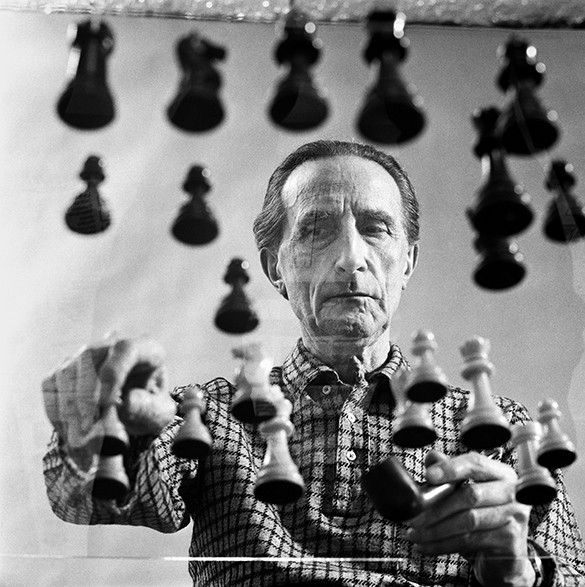
Arnold Rosenberg
Marcel Duchamp, 1958 / printed 2015
Selenium toned silver gelatin print
Image: 12 x 12 in. (30.5 x 30.5 cm)
Paper: 20 x 16 in. (50.8 x 40.6 cm)
Edition of 16 with 3 APs
Titled, dated, numbered and stamped on verso
© Sean Kelly, New York Courtesy: Sean Kelly, New York
Hackney’s chess paintings virtually make literal the formal and strategic potential that Duchamp once claimed a visual transcription of chess could yield:
Objectively, a game of chess looks very much like a pen-and-ink drawing, with the difference, however, that the chess player paints with black-and-white forms already prepared instead of inventing forms as does the artist. The design thus formed on the chessboard has apparently no visual aesthetic value and is more like a score for music which can be played again and again. Beauty in chess does not seem to be a visual experience as in painting. Beauty in chess is closer to beauty in poetry; the chess pieces are the block alphabet which shapes thoughts; and these thoughts, although making a visual design on the chessboard, express their beauty abstractly, like a poem.
Particularly remarkable about Hackney’s paintings is the surprising amount of variation seen in the series, a testament to the success of his process in eliciting visually distinct statements under such severe formal constrictions. For Hackney, both painting and Duchamp’s chess games function like readymade materials—the beauty is in the unexpected brilliance of their synthesis. Like the artful chess player’s sacrifice of a pivotal piece, Hackney’s process requires a tremendous sacrifice of aesthetic subjectivity, as he executes the procedure with the necessary impartiality to make the system work. “My authorship seems to take place conceptually, before the painting materializes,” Hackney once remarked. “In this respect, failure is neutral—that’s not really where my concern rests in this work.” While it is tempting here to reference Duchamp biographer Robert Lebel’s observation that the French word for chess, échecs, also means failures, it is vital to reiterate that the “success” or “failure” of Hackney’s paintings in the traditional sense that an artist like Mondrian might have understood it requires a vastly different set of aesthetic criteria in order to make such a judgment, the same way that the readymade necessitated an entirely new aesthetic vocabulary in order to discuss it. Perhaps the determination of the “success” of Hackney’s paintings (and avant-garde art in general) requires a set of criteria more akin to the standards associated with the beautiful in chess: originality, daring, virtuosity, economy, and the expectation of the unexpected.
—Bradley Bailey, Associate Professor of Art History, Saint Louis University
Memoirs of a Chess Square
At the beginning of many prestigious chess tournaments, players sign their name on particular light squares of commemorative chessboards, often with no intent beyond the thought, “On which square will my signature appear most elegant?” or, “Which square is left to sign?” And yet, specific squares hold so many memories of sacrifices both successful and failed as well as nightmares of a sacrifice or in-between move. This makes the question, “What’s your favorite square?” far more pertinent than the query frequently asked by journalists who don’t play chess: “What’s your favorite piece?”
I first saw Tom Hackney’s chess paintings in the exhibition The Knight Turns Its Head and Laughs, held at Greenwich University in London in 2011. The show included only a few chess paintings. Over traditional pub food by the Thames, Hackney told me that he uses the moves of a chess game to “generate form, whereby that form is encoded.” Greenwich is known for being the location where Greenwich Mean Time (GMT) is calculated. Fitting with that fact, while time is a crucial element in the chess game itself, we record the game to make it timeless. You can fit the entirety of a chess game in a small space using algebraic or descriptive notation, but reading it without a chessboard takes years of practice. And thus Hackney condenses timeless battles in his paintings, where you can choose to take in the contours of a battle in a glance, or look deeply to understand it more fully.
One of Hackney’s chess paintings, Chess Painting No. 71 (Marcel Duchamp vs. E.H. Smith, Hyéres, 1928), 2016, is inspired by a game I know well. In Naked Chess (2009), a video installation I created with Daniel Meirom, we reversed the iconic image of Marcel Duchamp playing against a nude woman, artist and author Eve Babitz, at the opening of Duchamp’s 1963 retrospective at the Pasadena Museum of Art. Using a chess set in which the pieces were carved nude figures, I played against a young naked man. This work was featured in the World Chess Hall of Fame’s show, Ladies’ Knight: A Female Perspective on Chess. We used the game Marcel Duchamp – E.H. Smith as a text for the piece, which Hackney also utilized for one of his chess paintings. The most memorable squares in this game are d6 and e5. D6 is the location of lovely exchange sacrifice, in which Duchamp gives up a rook for a bishop.
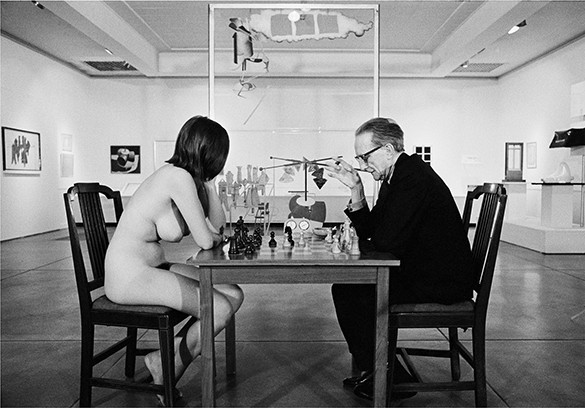
Julian Wasser
Marcel Duchamp, Pasadena, 1963
Black and white photograph
7 ½ x 9 ½ in.
Courtesy of Julian Wasser
©1963 Julian Wasser
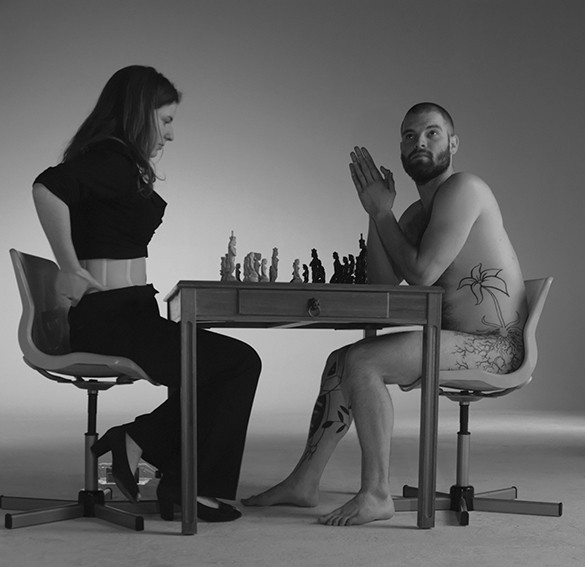
Jennifer Shahade and Daniel Meirom
Naked Chess, 2009
Black and white photograph
20 ½ x 20 ½ in.
Courtesy of the artists
Photo: Jennifer Shahade and Daniel Meirom
In Hackney’s piece, one can see how the exchanges on d6 are reflected in the dualcolored square.
E5 is layered with multiple paths, including the dominating final position, in which the queen moves to the central square with devastating effect.
In my video installation, we imagined the position beyond the actual finale, where Smith resigned. I presumed that my opponent would allow me to use my queen to deliver the final checkmate on the g7 square, which is blacked out in Hackney’s painting.
As for me, I remember playing my favorite move on the d5 square in a game that I have since misplaced, and so only the memory of a spectacular rook sac in the Dragon remains. My favorite chess position is Richard Réti’s simply geometric composition, in which the first move, Kg7, shows the beauty of chess and geometry in the most elegant way possible. I feel a twinge of envy when I start teaching a newcomer to chess, as they will get to see this position for the first time.
I edited two pieces for US Chess’s website called “64 Square Tour” (2007), written by Bart Gibbons and “64 Square Problem Tour” (2008), authored by Gary Kevin Ware. These articles showcased the most memorable moves on each square of the chessboard from a1 to h8. I return to these articles again and again, because in addition to providing 64 beautiful chess moves, they form a larger whole in marking the entire chessboard: many squares within one master square. They also point to the tension inherent in defining aesthetics in chess. Which are more important, moves that cause amateurs and/or professionals to feel thrills of surprise or moves that are objectively strong?
In formal properties, surface level beauty, and deeper historical references, Hackney’s paintings explore and expand the various ways that we can call chess art.
“All artists are not chessplayers, but all chessplayers are artists,” Marcel Duchamp famously said, and we can now add that all paintings are not chess games, but all chess games are paintings.
—Jennifer Shahade, Chess Champion and author
The Black and White Paintings
Hackney begins with an unprimed, stretched linen canvas, on which he draws a light grid in pencil. He then takes the moves from a preselected chess game and uses them to determine the placement of his painted forms by plotting the movements of the chessmen on the grid. The path of each move on the board is plotted, masked, and painted with a roller in sequence, from the opening move to the last. The width of the line representing each move is determined by the dimensions of the square; diagonal moves are wider than horizontal or vertical ones because diagonal moves derive from the hypotenuse of the square, while horizontal and vertical moves are the width of one side.
The paths of the moves are painted in black or white gesso, a chalky painting material traditionally used to prepare, or “prime,” a surface (as it was the first or primary layer of paint) so that the successive layers of paint would adhere to it. While the black is opaque, and therefore conceals anything under the painted surface, the white gesso is translucent, and thus subtly reveals prior moves—the more saturated the whiteness of a painted area, the more passes it contains. Similarly, areas of gray result from regions in which the trail of white pieces have passed over those of black pieces, which hints at the potential value spectrum between white and black that is—much like the number of moves in the chess game—virtually limitless.
The areas that are not traversed by any moves retain the taupe hue of the bare canvas, adding color to the otherwise achromatic design. Hackney’s use of gesso points to both material and symbolic elements in his work. According to the artist, the purpose of the gesso “is structural rather than visual—it is the material that exists beneath the surface of most of the paintings ever created. Similarly, I feel Duchamp’s works and ideas leave a legacy of underlying structures in much of the art made after his life—especially with regard to the challenges posed to painting by the readymade. This aspect is the basis of all of the chess paintings.”
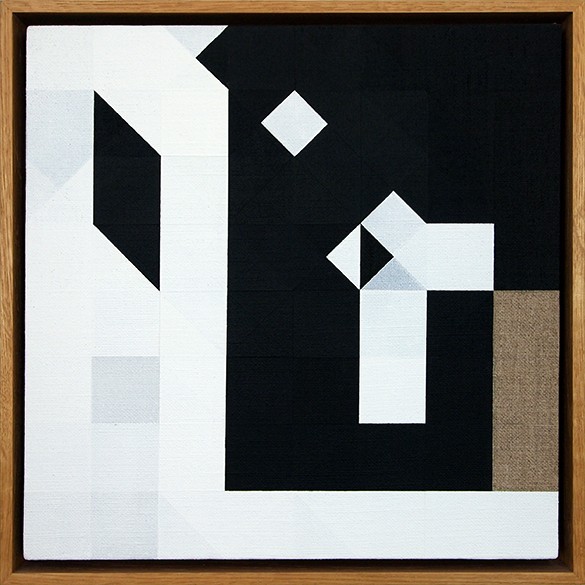
Tom Hackney
Chess Painting No. 2 (Duchamp vs. Crepeaux, Nice, 1925), 2009
Gesso on linen, oak frame
12 ½ x 12 ½ in.
Collection of Dr. Ed Krčma
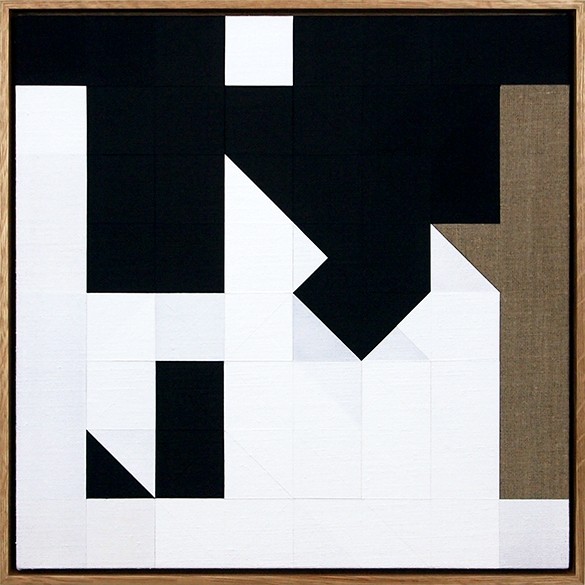
Tom Hackney
Chess Painting No. 6 (Duchamp vs. Schroeder, New York City, 1922), 2011
Gesso on linen, oak frame
16 ½ x 16 ½ in.
Courtesy of Francis M. Naumann Fine Art, New York
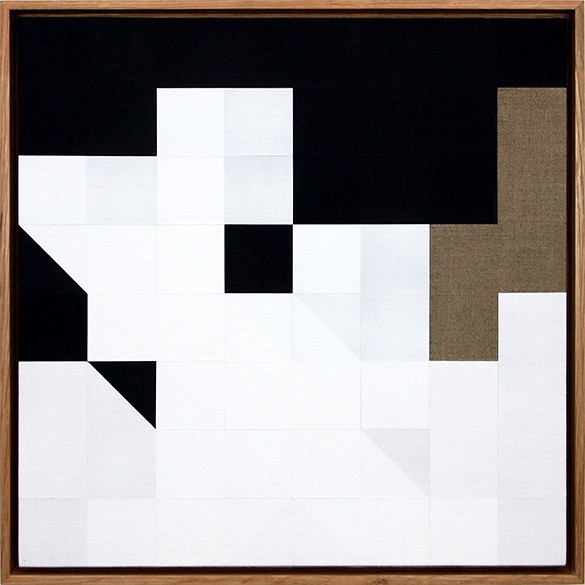
Tom Hackney
Chess Painting No. 50 (Duchamp vs. Hanauer, New York, 1952), 2015
Gesso on linen, oak frame
16 ½ x 16 ½ in.
Courtesy of Francis M. Naumann Fine Art, New York
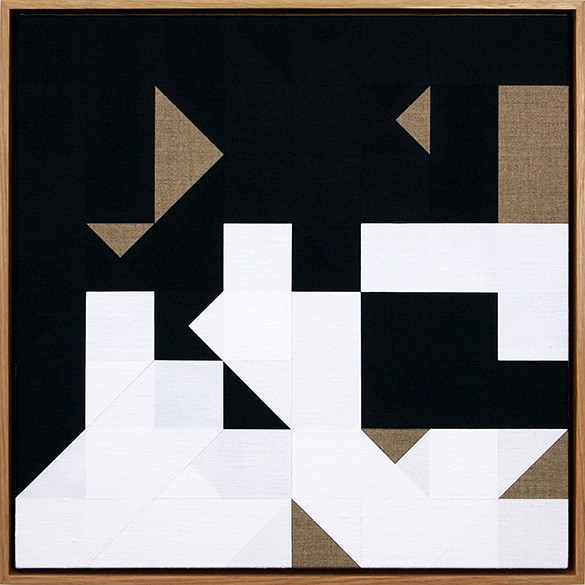
Tom Hackney
Chess Painting No. 64 (Duchamp vs. Znosko-Borovsky, Paris, 1929), 2015
Gesso on linen, oak frame
16 ½ x 16 ½ in.
Courtesy of Francis M. Naumann Fine Art, New York
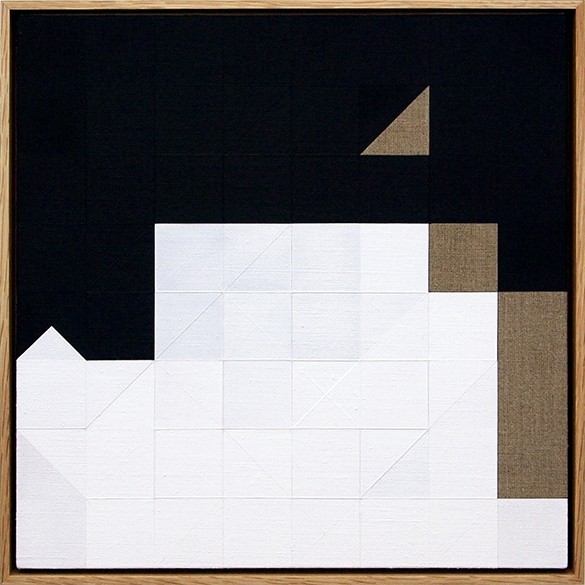
Tom Hackney
Chess Painting No. 65 (Duchamp vs. Evans, New York, 1948), 2015
Gesso on linen, oak frame
16 ½ x 16 ½ in.
Courtesy of Francis M. Naumann Fine Art, New York
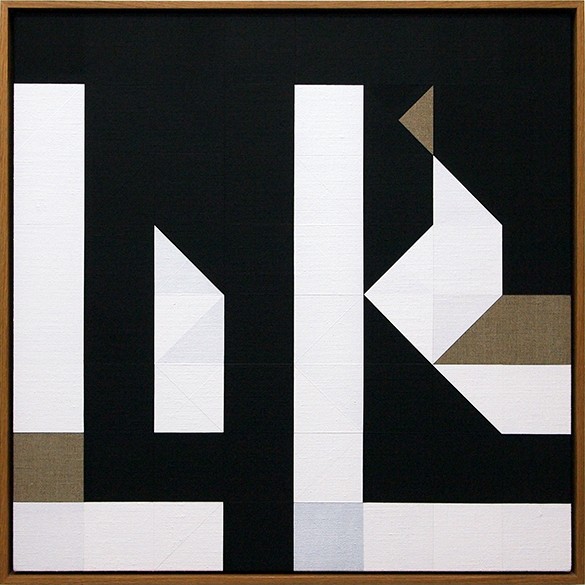
Tom Hackney
Chess Painting No. 66 (Duchamp vs. Lilienthal, Folkestone, 1933), 2015
Gesso on linen, oak frame
26 x 26 in.
Courtesy of Francis M. Naumann Fine Art, New York
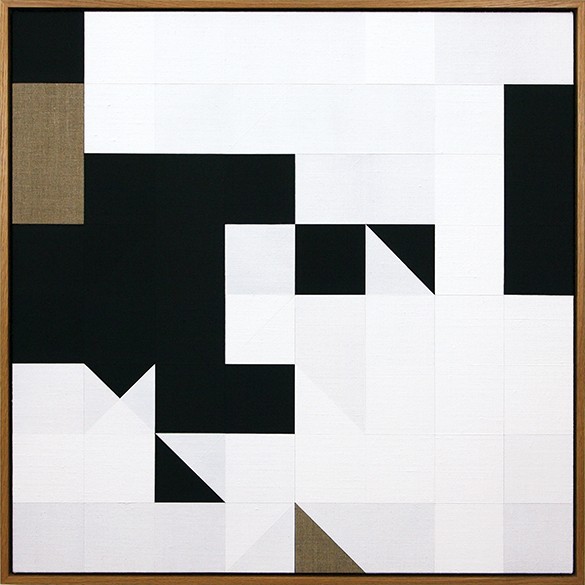
Tom Hackney
Chess Painting No. 67 (Kmoch vs. Duchamp, Hamburg, 1930), 2016
Gesso on linen, oak frame
26 x 26 in.
Courtesy of Francis M. Naumann Fine Art, New York
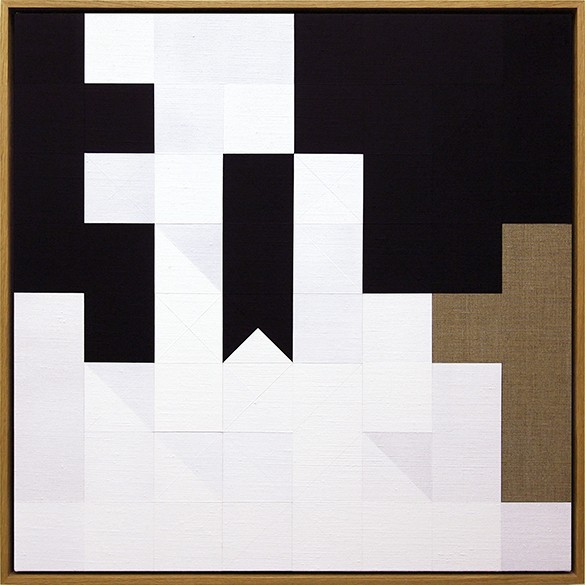
Tom Hackney
Chess Painting No. 68 (Opocensky vs. Duchamp, Folkestone, 1933), 2016
Gesso on linen, oak frame
26 x 26 in.
Courtesy of Francis M. Naumann Fine Art, New York
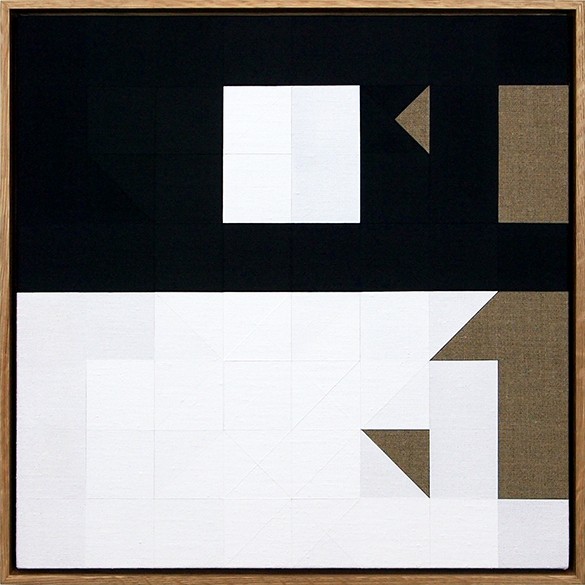
Tom Hackney
Chess Painting No. 70 (Duchamp vs. B.P. Reilly, Nice, 1931), 2016
Gesso on linen, oak frame
16 ½ x 16 ½ in.
Courtesy of Francis M. Naumann Fine Art, New York
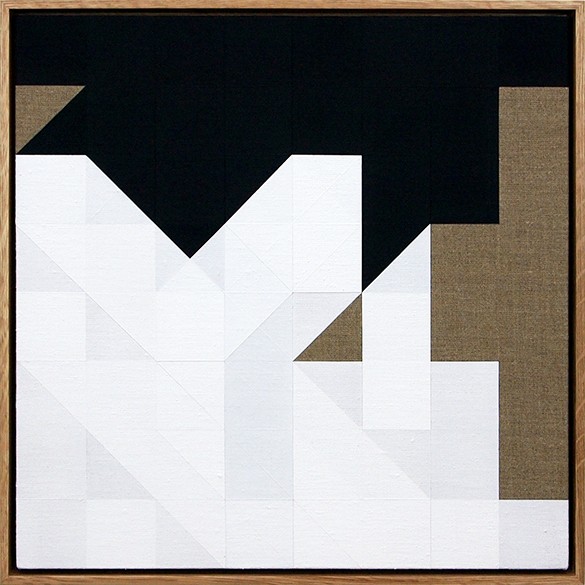
Tom Hackney
Chess Painting No. 71 (Marcel Duchamp vs. E.H. Smith, Hyéres, 1928), 2016
Gesso on linen, oak frame
16 ½ x 16 ½ in.
Courtesy of Francis M. Naumann Fine Art, New York
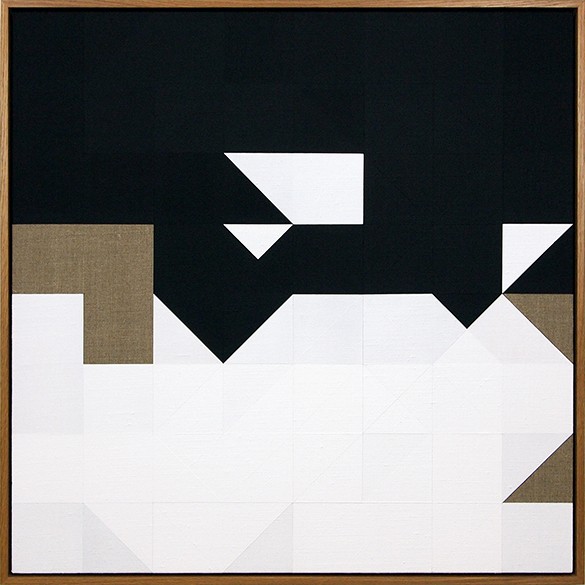
Tom Hackney
Chess Painting No. 72 (Duchamp vs. Muffang, Strasbourg, 1924), 2016
Gesso on linen, oak frame
26 x 26 in.
Courtesy of Francis M. Naumann Fine Art, New York
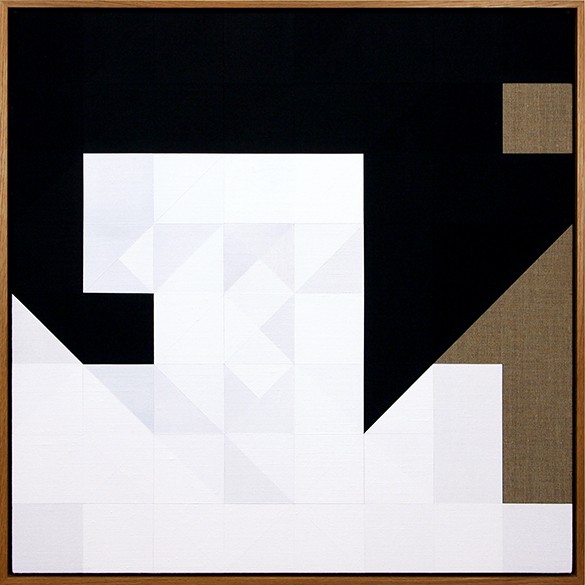
Tom Hackney
Chess Painting No. 73 (Rosselli del Turco vs. Duchamp, Nice, 1931), 2016
Gesso on linen, oak frame
26 x 26 in.
Courtesy of Francis M. Naumann Fine Art, New York
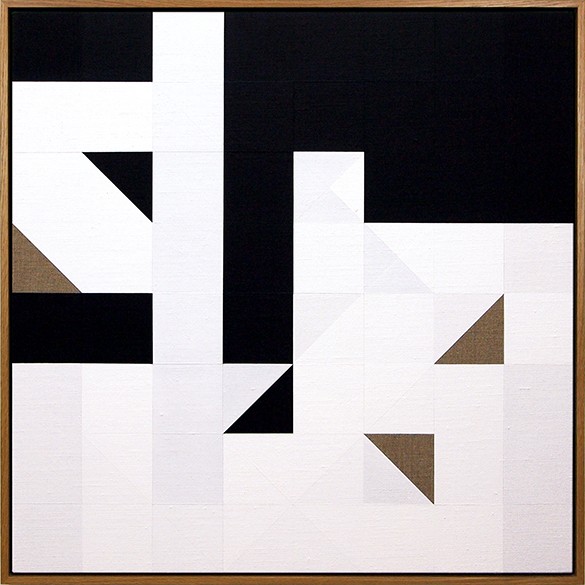
Tom Hackney
Chess Painting No. 74 (Duchamp vs. Devreese, Brussels, 1923), 2016
Gesso on linen, oak frame
26 x 26 in.
Courtesy of Francis M. Naumann Fine Art, New York
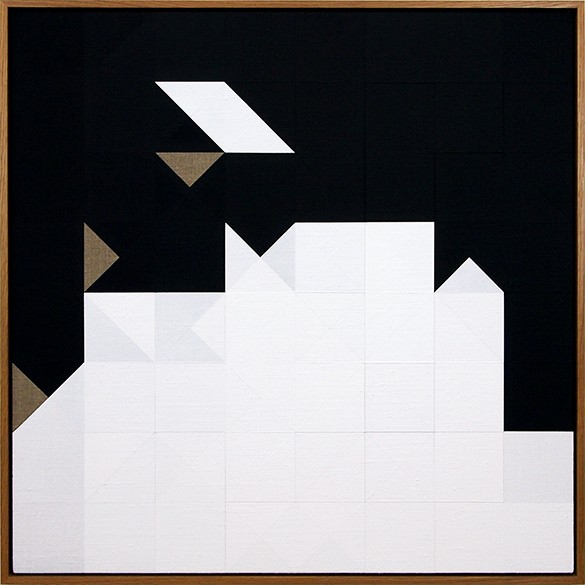
Tom Hackney
Chess Painting No. 75 (Duchamp vs. Noteboom, Nice, 1931), 2016
Gesso on linen, oak frame
26 x 26 in.
Courtesy of Francis M. Naumann Fine Art, New York
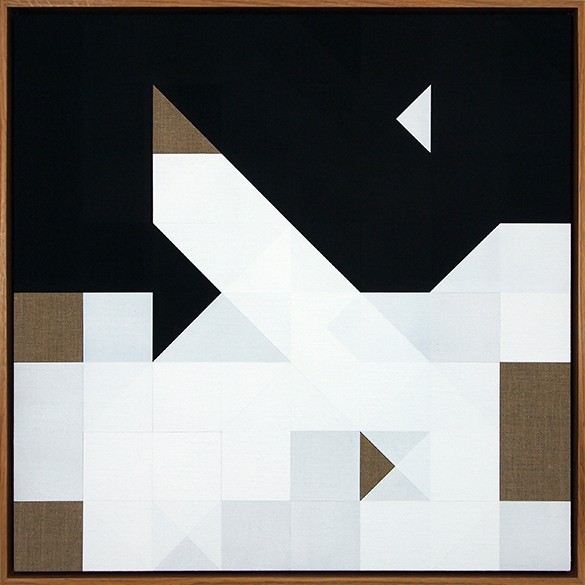
Tom Hackney
Chess Painting No. 79 (Duchamp vs. Rozic, Paris, 1924), 2016
Gesso on linen, oak frame
26 x 26 in.
Courtesy of Tom Hackney
The Color Paintings
The color canvases follow a procedure that is similarly predetermined to the black-and-white paintings, though in this case the order is changed. In the black-and-white paintings, the application of gesso follows from the first move of the chess game to the last, whereas in the color paintings, bright swatches of acrylic or oil paint describe the contest beginning with the last move and ending with the first.
According to Hackney, “My reason for this was to explore the composition brought about by various openings—where the course of each game takes so many twists as to deliver a specific, unique end, the opening of each game is made according to a smaller set of conventions. In the paintings, one result of this is that certain openings are much more detectable in the color paintings, thus the works become visually more similar—like minor variations on a theme.” As with the black-and-white paintings, the serial nature of the color paintings is also critical, as much of the understanding of these works comes with the recognition of nuanced disparities from canvas to canvas that both art and chess aficionados may appreciate, though not necessarily for the same reasons.
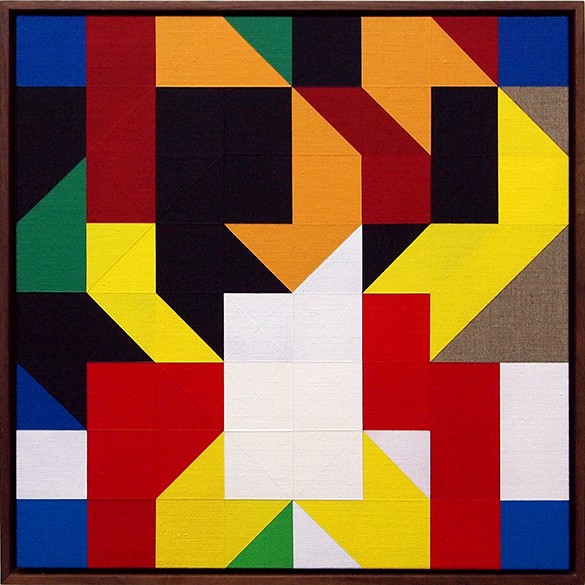
Tom Hackney
Chess Painting No. 54 (Michel vs. Duchamp, Strasbourg, 1924), 2015
Gesso and acrylic on linen, walnut frame
16 ½ x 16 ½ in.
Collection of Andrew Molyneux
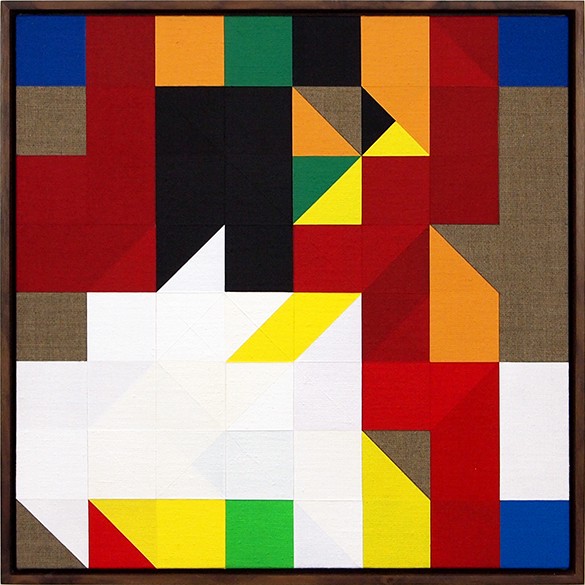
Tom Hackney
Chess Painting No. 59 (Duchamp vs. Steiner, Paris, 1924), 2015
Gesso and acrylic on linen, walnut frame
16 ½ x 16 ½ in.
Courtesy of Francis M. Naumann Fine Art, New York
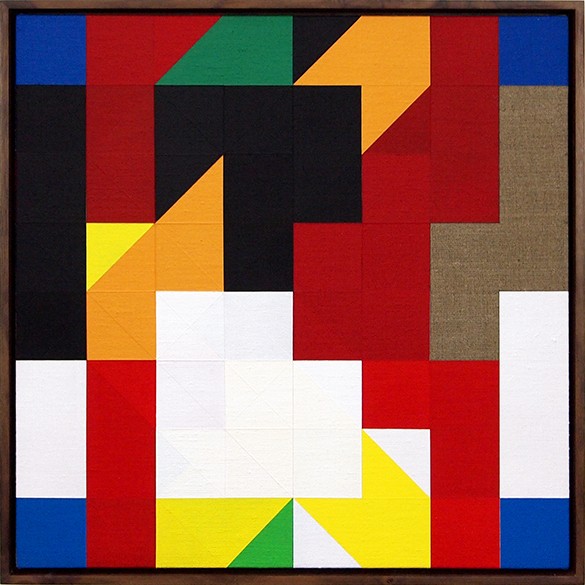
Tom Hackney
Chess Painting No. 61 (Duchamp vs. Hanauer, New York, 1952), 2015
Gesso and acrylic on linen, walnut frame
16 ½ x 16 ½ in.
Courtesy of Francis M. Naumann Fine Art, New York
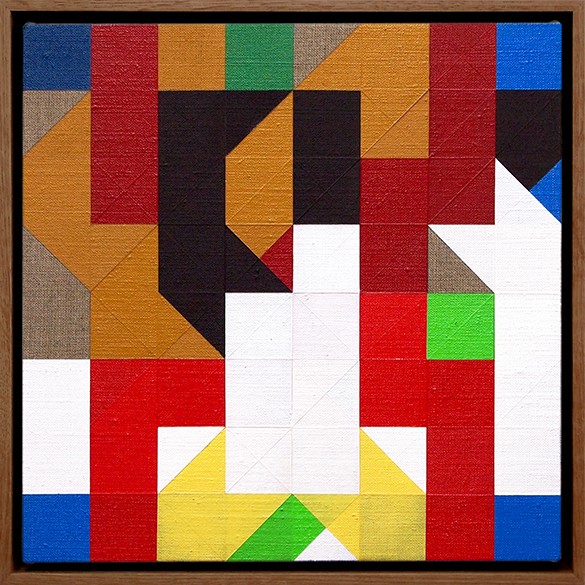
Tom Hackney
Chess Painting No. 62 (Grimme, Luuring, Ree & Krabbe vs. Duchamp, correspondence game, 1961), 2016
Oil on linen, walnut frame
12 ½ x 12 ½ in.
Collection of Steve and Terri Hoffman
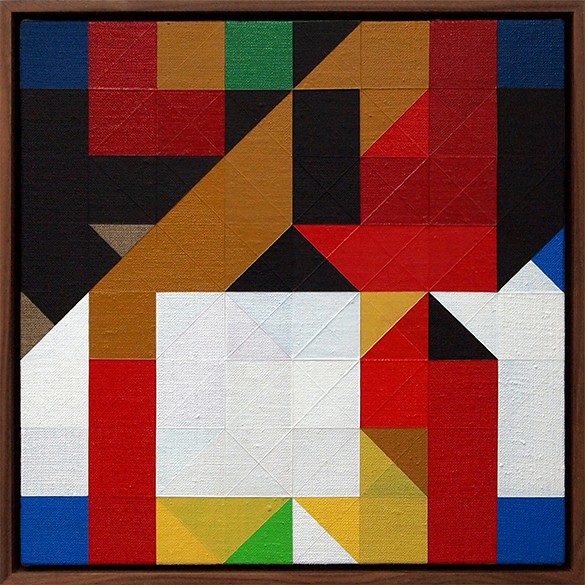
Tom Hackney
Chess Painting No. 63 (Duchamp vs. Takacs, correspondence game, 1932), 2016
Oil on linen, walnut frame
12 ½ x 12 ½ in.
Courtesy of Francis M. Naumann Fine Art, New York
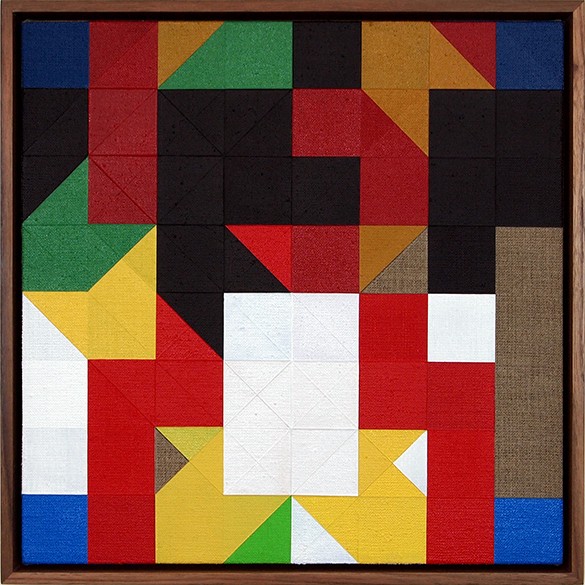
Tom Hackney
Chess Painting No. 69 (Suren vs. Duchamp, Strasbourg, 1924), 2016
Oil on linen, walnut frame
12 ½ x 12 ½ in.
Courtesy of Tom Hackney
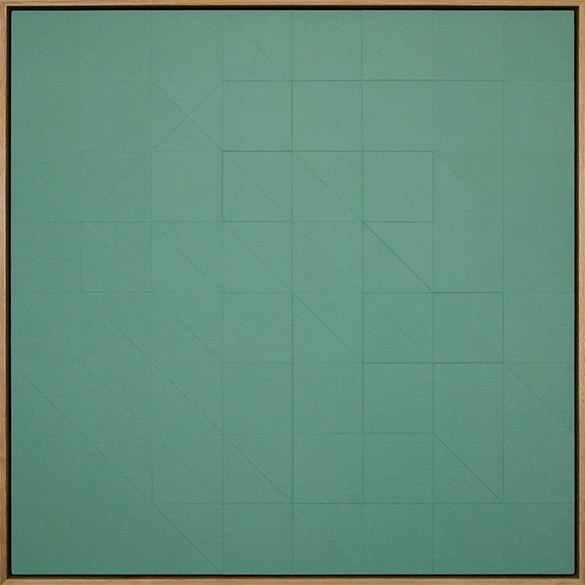
Tom Hackney
Chess Painting No. 85 (Duchamp vs. Przepiorka, Hamburg, 1930), 2016
Gesso on linen, oak frame
35 ½ x 35 ½ in.
Courtesy of Tom Hackney
Duchamp Chess Pieces
Hackney followed the black-and-white canvases with more colorful designs, based not only on Duchamp’s games, but also on a unique proposal for a chess set that Duchamp first suggested in 1920. The design of the set itself is rather conventional, unusually so for someone of Duchamp’s rebellious nature, but the twist that he proposed that made this design exceptional was not one of shape, but of color. In this set, color signifies the moves of the queen, bishop, knight, and rook, while the kings and pawns remained the traditional black and white.
The queens are colored a lighter and darker tint of green, as the potential movement of the piece encompasses the movements of both the rook and bishop, which are colored lighter and darker blues and yellows, respectively. The knight, whose distinctive path shares no characteristics with the other pieces, is colored in different values of red. Duchamp’s plan was to market this chess set using the name of one of the greatest players of the day, Frank Marshall, whose famous chess club in New York counted Duchamp among its membership. While it is unknown whether this business venture was ever even proposed to Marshall, a description of a “beautiful set of painted chessmen” that Henri-Pierre Roché saw in Duchamp’s Paris apartment in 1922 suggests that at least one set of “Marshall’s Chessmen” was produced, though there are no known versions of this color-coded set in existence today.
Duchamp and Chess
One of the most inspirational figures of the twentieth century and a cultural icon, Marcel Duchamp played a fundamental role in redefining art for the modern era. In the tradition of such venerable names from the history of the French avant-garde as Gustave Courbet, Edouard Manet, and Paul Cézanne, Duchamp challenged the conventional understanding of art to its very fiber, questioning long-held preconceptions regarding what art could be, how it could be made, and how it was intended to function as a vessel for the communication of ideas. While World War I was raging in Europe and industry boomed in the United States, Duchamp found that traditional painting and sculpture were no longer capable of expressing the experience of the modern world. In response, he developed a new medium, the readymade, an everyday object that is taken from material culture and transformed into a work of art simply through its selection by an artist and the context of its display. Duchamp’s shift away from traditional media—from “art as object” to “art as idea”—remains one of the most significant and innovative developments in the history of art, and has inspired generations of artists after him to explore new modes of art production.
While Duchamp will long be remembered as one of the most brilliant and provocative figures in the history of art, many who knew him would argue that his true passion was not art, but chess. He threw himself completely into the game when he began playing competitively in the early 1920s, quickly rising through the ranks of the French professionals and earning the respect of the more talented and seasoned masters. He studied the game with tremendous ferocity, and achieved master status in France after only two years of regular tournament play. While he never succeeded in his goal of becoming the French chess champion, his accomplishments were remarkable for a largely self-taught player who did not enter into the competitive arena until his mid-thirties. His most important achievements include winning the Chess Championship of Haute-Normandie in 1924, draws against such greats as Savielly Tartakower, Vera Menchik, Eugène Znosko-Borovsky, and the illustrious American Grandmaster Frank Marshall, and a victory over the brilliant blindfold exhibitionist George Koltanowski. Duchamp also made significant contributions to the chess community through the written word, authoring a chess column in the Parisian daily newspaper Ce Soir, translating Znosko-Borovsky’s book on chess openings into French, and coauthoring a book on endgame tactics with Vitaly Halberstadt titled L’Opposition et les cases conjuguées sont réconciliées (Opposition and Sister Squares Are Reconciled). What may remain Duchamp’s greatest accomplishment as an artist and chess player, however, is the attention he has drawn to the point at which the two intersect, where the cerebral side of the creative act meets the artistry of the royal game.
Press
9/7/16: All the Arts — Tom Hackney: Corresponding Squares: Painting the Chess Games of Marcel Duchamp Review (download)
7/8/16: Peter Gill — Tom Hackney: Corresponding Squares: Painting the Chess Games of Marcel Duchamp (download)
6/24/16: Lost On Time — Hackney Seen in St. Louis, Etc.
5/21/16: The Ex Expat — The Art In Chess
5/20/16: Art Daily — Tom Hackney debuts new exhibit of paintings at the World Chess Hall of Fame
5/12/16: St. Louis Public Radio — On Chess: Tom Hackney exhibit opens in the chess capital of the U.S.
5/5/16: Press Release — British Artist Tom Hackney Debuts New Exhibit of Paintings at the World Chess Hall of Fame (download)
3/22/16: The Art Newspaper — Meticulously charting Marcel's chess moves
3/19/16: Dallas Art Dealers Association — Exhibition of paintings by Tom Hackney on view at Francis M. Naumann Fine Art
3/19/16: Art Daily — Exhibition of paintings by Tom Hackney on view at Francis M. Naumann Fine Art

